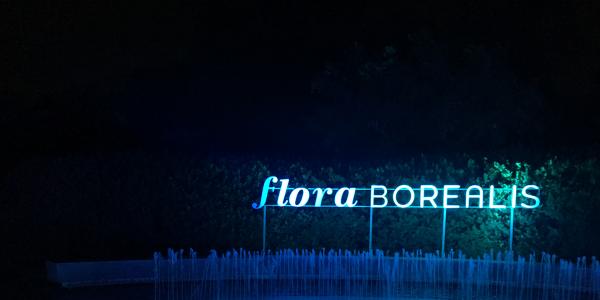Megan Steigerwald Ille is a postdoctoral fellow in digital culture in the Program in American Culture Studies.
“Immerse yourself in a surreal Garden experience at Flora Borealis!” I scanned the advertising banner that had just appeared on my phone screen, paused, and kept on scrolling, lost deep within my Facebook newsfeed as my eyes glazed over and I tuned out the sound of conversations around me.
Flora Borealis was a “nighttime multimedia experience” performed at the Missouri Botanical Gardens from June 28 to August 26, and then again from September 6 to October 20, 2018. Audience members purchased tickets at the Ridgeway Visitor’s Center and then walked through a one-mile path around the gardens, stopping at twelve points along the way. The pathway was lit by lasers streaming into the fog above audience members and displays projected onto trees and structures, while interactive sound exhibits and a soundtrack composed by Marc Bell pulsed and thrummed around spectators. At one point, in the “talking trees” section of the performance, floorboards built around trees vibrated under visitors’ feet as sagacious white basswood trees described their hundreds of years of growth in St. Louis.
In Flora Borealis, “immersivity” seems to be a keyword used to situate the performance within the experience economy, in which a higher commodity value is afforded to an experience rather than a good or service. The sum of the event of Flora Borealis—music, lights, audience participation in a space normally out of bounds at night—adds up to an “Instagrammable” and immersive experience.
While “immersion” as an advertising gimmick, form of aesthetic experimentation, and technological possibility seems to be everywhere, what beyond a buzzword might this concept imply? Scholars of cultural studies have explored how historical and contemporary contexts of listening can radically influence the use of various technologies; however, notions of immersion signify more than aural experience. My work on the use of immersion as an aesthetic and commercial phrase addresses this gap and explores how “immersion” functions as a rhetorical marker signaling sensorial experiences within digital and physical landscapes. Contradictions of the sort I describe in my opening anecdote—reading about a physical event in a digital space, and then losing oneself within that digital space once more—foreground the tension between digital and physical realms common within many individuals’ everyday lives. Unpacking immersion in its various forms—commercial, aesthetic, everyday—is a way to understand how corporations, groups, and individuals structure reality within the neoliberal twenty-first century United States. While my broader research explores the notion of immersivity in site-specific and digitally mediated operatic performance, Flora Borealis offers an opportunity to think locally through themes of sensorial experience, digital media, and the experience economy.

My fall 2018 L98 330 course, “Virtual and Physical Space: Digital Practices and Sensory Experience,” explored many of the contradictions between our social media and physical existences. When we visited the Botanical Garden for Flora Borealis, students Lizzie Franclemont and Justin Ziegelmueller made direct connections between the offerings of the garden and that of pop-up museums such as the Museum of Ice Cream, the Museum of Selfies, and the Color Factory. These types of museums are designed around notions of participation and interactivity: visitors wander through colorful, multisensory spaces curated especially for their appearance when reproduced in digital spaces like Instagram (providing free advertising). Throughout the garden at Flora Borealis, signs were posted stating, “As your journey continues, don’t forget to share your photos on social media. #floraborealis.” Shareability translates into immersivity because it is a crucial way of defining engagement for large swaths of the American population—perhaps even constituting an additional sensory experience.
From one perspective, these digital forms of participation require a form of withdrawal from the experience itself. In transcribing the current moment to a digital format, the participant might be said to link herself to a long tradition of travel writing and photography, in which documentation could equal disruption. From another angle, however, sharing an event on social media becomes a way of contextualizing a personal experience within another framework of digital immersion such as a Twitter stream or Facebook newsfeed. The pleasure of digital self-fashioning is heightened by the sensory overload (and allure) of the newsfeed or Twitter stream as other users upload photos, videos and opinions related to concurrent happenings. Although immersivity typically implies a union of sensory experiences, this moment of fragmented code-switching between the physical and digital seems to be a recurring theme within commercially marketed immersive experiences, and indeed everyday life for many in the United States.
Does an immersive experience in the contemporary United States promise to reinforce reality, pushing the attendant into a heightened understanding of her or his world? Or does it stage a new reality, perhaps one in which digital and physical space compete for attention? Perhaps, as Flora Borealis might indicate, it does both.
Megan Steigerwald Ille wishes to thank American Culture Studies program for providing financial support for her class’s trip and to Catherine Martin and Ayanna Woods of the Missouri Botanical Garden for arranging discounted prices. She also wishes to thank Kedron Thomas, Douglas Flowe, Noah Cohan, Sarah Gaby, and Pete Benson for sharing a range of critical opinions and ideas that greatly enriched her thinking on digital and physical space and immersion.






